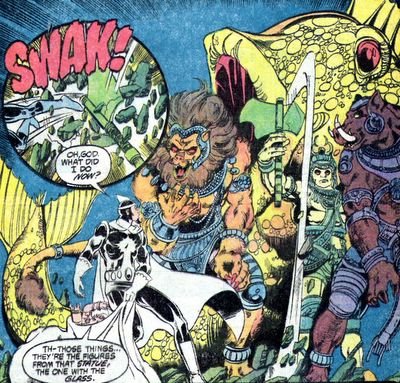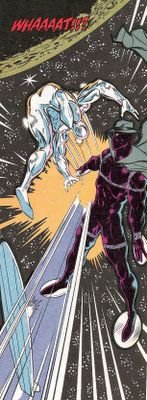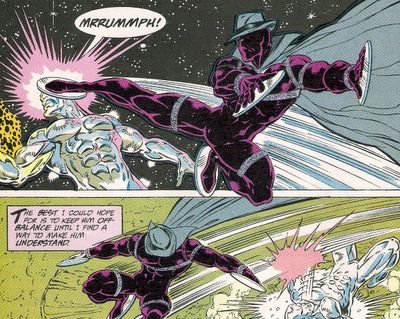
Alternate Reality Where Everybody Dies Week continues with this classic Avengers annual where yes, all the Avengers die horrible deaths but at the end everybody gets better and plays baseball together and ha ha ha, isn’t life grand?
Actually, nobody says, “Ha ha ha! Isn’t life grand?” in
Avengers Annual #16, but they do play baseball. But before we get to that upbeat ending – everybody dies. Except Cap and Hawkeye, naturally.
For a brief spell in the Eighties,
The Avengers annuals were actually really good. This flies in the face of a long tradition of suck-ass Marvel annuals full of second-rate filler material. In this case, a little iconoclasm is a good thing. (Look, I used the word “iconoclasm” in order to appear smart!) For a few years
The Avengers annuals were all killer, no filler.
This book was published during the era of the
West Coast Avengers, when all that superhero radness could not be contained in one Avengers team and had to be divided between two groups. Once a year, the East Coast playas and the West Coast killas met in the Astrodome for a friendly game of super-baseball.
Are you
laughing? Stop! I loved those books! Oh, I see, it’s okay if Cyclops and Wolverine play a game of half-court at Xavier’s, but it’s stupid when Iron Man and Captain America play baseball? In full costume?
Okay, maybe that does sound a little dumb.
Suiting up in state-of-the-art powered armor just to play center field is overkill. Maybe Iron Man is just being prudent, because every single time the two teams play baseball they get attacked by somebody. Come to think of it, the JLA and JSA can’t make it through a Thanksgiving meal, either. You would think superteams would learn and just not socialize in big groups.
“Gosh Jan, I’d love to come to your Oscar party, but last time the U-Foes trashed your condo and we never did find out who won Best Picture.”Picking up from the
West Coast Avengers Annual, this book pits a small army of Avengers against The Grandmaster (no relation to
Grandmaster Flash or his Furious Five), a nigh-omnipotent cosmic being who is obsessed with, as Hawkeye describes it, “crazy cosmic games.”
The Grandmaster has captured the personification of Death and uses her powers to resurrect a team of dead heroes and villains to pit against The Avengers. The opposing teams are split up into squads and cast across the universe, where they battle one another for possession of five inappropriately named “life bombs.” If the Avengers lose the universe blows up or something, and if The Avengers win… well, the universe still blows up, because The Grandmaster is a total asshole.

Legendary Marvel writer/editor Tom DeFalco handles the writing chores, but each battle is drawn by a different art team. My favorite chapter is the fight in Hades featuring Hawkeye, Hank Pym, and Thor, which has breakdowns by John Romita Jr with finishes by Bill Sienkiewicz. It is beautiful.
That brings us to our first death! During this period, Avenger Hank (aka Yellowjacket, Giant Man, Ant-Man, Crotch Spelunker, Wife Beater) Pym didn’t have an alter-ego or a costume, he was rockin’ an off-the-rack jumpsuit from JC Penney with lots of pockets. Believe me, it was better than the Members Only jacket and parachute pants Pym wore in 1986. Anyway, Pym used his incredible powers to shrink tools and weapons so he could stash them in his jumpsuit. When he needed, say, a grenade launcher he would just pull the tiny weapon out, hit it with Pym particles to make it grow, and within seconds he is armed and dangerous. If you ask me, this is a far more practical application of shrinking powers than making yourself two inches tall.
Anyway, Hank Pym battles the deceased Nighthawk while Thor tussles with Skurge and Hawkeye takes on The Swordsman. Pym holds his own, until her gets distracted by a collapsing roof. Watch your six, Pym!
Behind you!!!
Never mind. Hank gets stalagmited from behind, which reminds me of one drunken summer night in Bangkok. That’s a story for another time.
Thor whisks away The Grandmaster’s life-bomb but gets blowed up real good. Only Hawkeye survives this round.
The next chapter pits Tigra, She Hulk, Moon Knight, and Captain Marvel against Drax, the dead dude Captain Marvel, The Green Goblin, and Death Adder in sunny Maui. In reality, the living female Captain Marvel would make short work of the dead bad guys, but this is an Alternate Universe story, so she has to die in an undignified and nonsensical way.
She-Hulk gets taken out by Drax, who blindsides her and breaks her back, despite the fact that she routinely fights guys like him with no injury whatsoever. But here she is fighting both Drax and Tom DeFalco, who both want her dead, so die she must.

Next, Moon Knight gets taken out by The Green Goblin, who doses the all-white avenger of the night with hallucinogen gas and then zaps him. I can handle that – if The Green Goblin can fight Spider-Man to a standstill then he could certainly take out Moon Knight. I’d be embarrassed for The Green Goblin if he couldn’t.

Speaking of embarrassing, Tigra gets poisoned by Death Adder, a third-rate villain who was murdered by Scourge, if memory serves. Then dead dude Captain Marvel, Drax, and The Green Goblin all team up on the living female Captain Marvel and they kill her. Seriously, what is the frickin’ Green Goblin going to do against a woman who can turn herself into light? I call bullshit.
After that, The Silver Surfer goes up against all-powerful jock Korvac, and they both kill each other. I have no idea why The Silver Surfer is in this comic. Does he even play baseball?
The next chapter has fantastic art, with breakdowns by Jackson Guice and finishes by Kevin Nowlan. Iron Man, Mockingbird, Dr. Druid, and The Black Knight battle Terrax, Red Guardian, Dracula, and an earlier and deader version of The Black Knight in the ruins of some alien civilization which looks strangely like a bombed-out city on Earth. I don’t know, maybe the aliens were really into building with brick.
The thing I love about this chapter is that Dracula basically kills them all.
While Mockingbird and Black Knight kick ass on their respective foes, Iron Man defeats Terrax but burns out his red and white Yuletide armor in the process. The unarmored Tony Stark begins working on defusing Grandmaster’s life-bomb while nearby, Dr. Druid takes on Dracula in a hypno-battle.
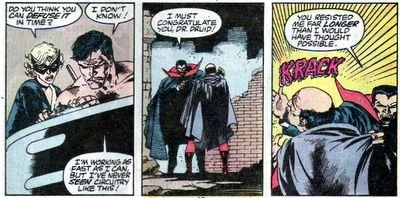
Pwned! Dr. Druid goes out like a chump, with a Mark V Backhand from Dracula! Looks like Tom DeFalco hated Dr. Druid as much as everybody else.
Iron Man is almost done defusing the bomb when Dracula appears and fucks everything up. Whatcha gonna do when the Lord of Vampires comes for you? Get distracted at a critical moment and blow up one fifth of the universe, that’s what!

Finally, Captain America, The Wasp, and Wonder Man take on Baron Blood, Hyperion, and – God, no! – Bucky, Cap’s dead partner from World War II!
I know what you’re thinking – but Bucky isn’t dead, he’s The Winter Soldier in Captain America! WTF? I have no explanation. Since Avengers Annual #16 precedes writer Ed Brubaker’s Captain America run by nearly two decades, I’m going to say that this book is canon and the current Cap storyline doesn’t count and Ed Brubaker is a big fat liar.

Death has turned Bucky mean, and he kills The Wasp by punching her. You see what I mean about shrinking powers? If you could choose between carrying a shrunken arsenal in your pocket or the ability to shrink to wasp-size, which would you choose? If a 12-year old boy can kill you with one punch, it’s official: your superpower sucks.
Cap is the only person who survives this round, and he joins Hawkeye back in front of The Grandmaster, who announces a change in the rules: now Cap and Hawkeye have to fight all the dead bad guys and all their dead friends, too! See? Asshole!
Hawkeye hasn’t stayed in one piece on The Avengers by being stupid; with the fate of reality at stake, the archer comes up with one last desperate gamble, a game of chance that The Grandmaster can’t resist:
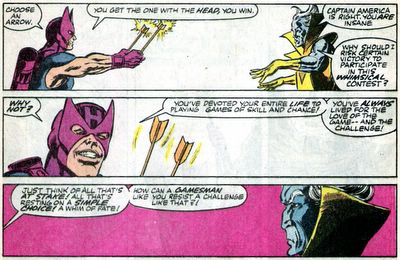
If Grandmaster picks the arrow with the head, everybody dies! If he picks the wrong one, everybody lives! Which one should he pick? Which one?!!

Sucker! Hawkeye cheated! Grandmaster picks the wrong arrow and is so distracted that Death frees herself and casts Grandmaster into The Negative Zone or something.

I have to give that scene a hearty F*&% Yeah! I loved that when I was a kid, that is a straight-up James T. Kirk move right there. Take that, godlike cosmic being! That's what you get for underestimating us humans, punk!

Out of gratitude, Death resurrects the entire team so they can finish their baseball game and ha ha ha, isn't life grand?
Lessons learned: Death can be a kind mistress, never turn your back on a bad guy, keep your mind on your business when defusing life-bombs, and don’t shrink down to punchable wasp-size during a super-battle.






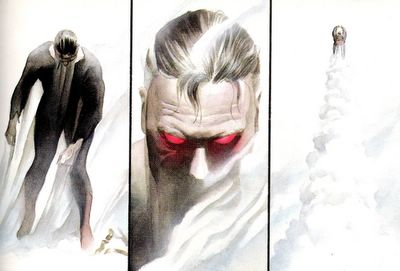



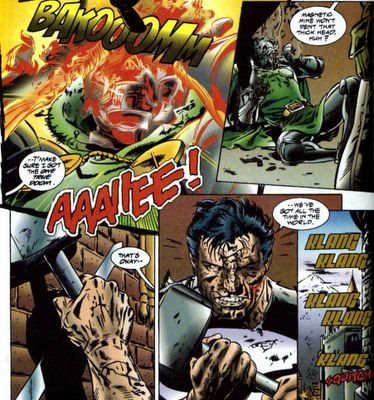

















 Cooke is the writer/artist of the Eisner-winning New Frontier and a swingin’ run on the Catwoman series. He also may be a time traveler from the year 1958, I’m not entirely sure. Cooke certainly has an affinity for the go-go 50’s and hep early 60’s, and it shows in his vibrant work and his use of characters like private eye Slam Bradley and The Question.
Cooke is the writer/artist of the Eisner-winning New Frontier and a swingin’ run on the Catwoman series. He also may be a time traveler from the year 1958, I’m not entirely sure. Cooke certainly has an affinity for the go-go 50’s and hep early 60’s, and it shows in his vibrant work and his use of characters like private eye Slam Bradley and The Question.








